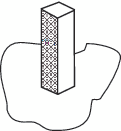PCLIP
Specifies whether a clipped polygon is stored in
its clipped or unclipped form.
| Used by: | GOPTIONS statement |
| Default: | NOPCLIP |
| Restriction: | not supported by Java or ActiveX |
| See: | POLYGONCLIP |
Details
When a procedure produces
a graph with intersecting polygons or blanking areas, it clips portions
of the polygons to prevent the ones behind from showing through.
When the graph is created and stored in a catalog, if PCLIP is in
effect, the clipped form of the polygon is stored with it. If NOPCLIP
is specified, the complete polygon is stored in the catalog and the
graph is clipped each time it is replayed.
For example, suppose
you create a block map like the one in Intersecting Polygons.
The block clips the
boundary of the map area polygon. If you specify PCLIP, the map area
polygon is stored in its clipped form, as shown in Clipped Polygon with PCLIP Option.
NOPCLIP stores the map
area in its unclipped form, as shown in Clipped Polygon with NOPCLIP Option.


